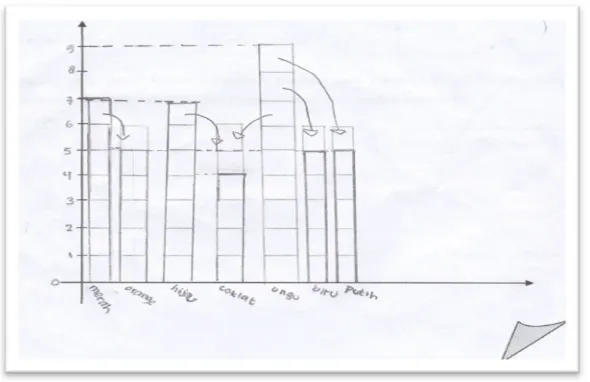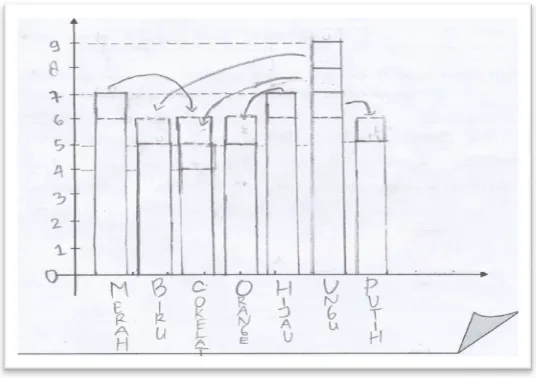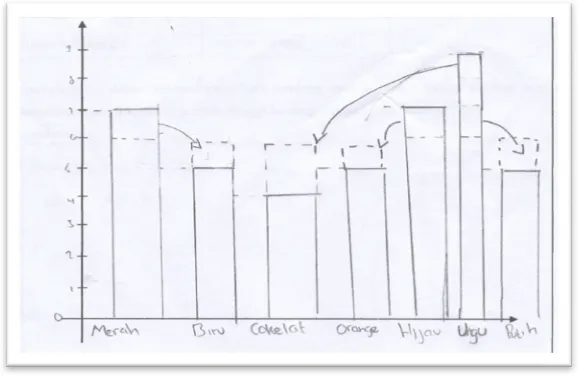165
The Legend of Kemaro Island for Supporting Students in Learning Average
Lestariningsih, Ratu Ilma Indra Putri, Darmawijoyo
Abstract
This research is aimed to determine the role of Indonesian folklore context namely the Legend of Kemaro Island in supporting average learning on 6 grade students with Pendidikan Matematika Realistik Indonesia (PMRI) approach. The method used is a design research that contains three stage namely preliminary design, teaching experiment, and retrospective analysis. Results from the research shows that Indonesian folklore context can support students to develop their knowledge in the concept of average. Strategy and model (emergent modeling) that students discover, describe and discuss the construction or contribution shows how students can use to help their initial understanding of the concept of average.
Key words: The Legend of Kemaro Island, PMRI, average
Abstrak
Penelitian ini bertujuan untuk mengetahui peranan konteks cerita rakyat Indonesia yaitu Legenda Pulau Kemaro dalam mendukung pembelajaran rata-rata di kelas 6 dengan pendekatan Pendidikan Matematika Realistik Indonesia (PMRI). Metode yang digunakan adalah design research dengan tahap preliminary design, teaching experiment, dan retrospective analysis. Hasil dari penelitian menunjukkan bahwa cerita rakyat Indonesia dapat mendukung siswa untuk mengembangkan pengetahuan mereka tentang konsep rata-rata. Seluruh strategi dan model (emergent modeling) yang siswa temukan, gambarkan dan diskusikan menunjukkan bagaimana konstruksi atau kontribusi siswa dapat digunakan untuk membantu pemahaman awal mereka tentang konsep rata-rata.
Kata kunci: Legenda Pulau Kemaro, PMRI, rata-rata
Introduction
Statistics widely applied in various disciplines, for example natural science, business
and industry. Almost every decision made in the field of politics and economics of
using a statistical reasons (Bakker, 2004). Therefore, the statistics need to be
introduced to students early on. About teaching and learning activities in elementary
statistics in general emphasizes concentration on the size of the data average and
According to Bakker (2004) stated that the average is the basic concept is very
important for students when they first learn to measure the concentration data. But the
process of learning the concept of average largely done by giving the formula directly
without first learning about the basic concepts and procedures are meaningful for
students (Groth, 2006). Teaching-learning process such as this raises for
understanding low that it will further lead to students experiencing learning
difficulties and errors in the average.
Furthermore, based on the above problems we need a way of learning the concept of
an average of interesting and meaningful to students so they become more motivated
to learn, both about the basic knowledge and concepts. Learning approach is in line
with Pendidikan Matematika Realistik Indonesia (PMRI). PMRI learning activities in
accordance with one of the principles of curriculum development that is centered on
the students (student center) while the teacher is only as facilitators. PMRI is
developed according to the context or cultural values that exist in Indonesia.
According Gadanidis and Hoogland (2002) explained that the story could be a context
for the story is a form of thinking and communicating naturally and provides a
meaningful way to talk and think about teaching and learning mathematics.
Researchers chose Legend Kemaro Island as a starting point because in the story there
is a mathematical value that can be raised is introduced to the students about the
diversity of data and average values and character education. Researchers provide an
alternative concept learning problems in the average by designing and developing
students' learning trajectories of island legend Kemaro as context associated with the
concept of average PMRI approach.
We use some theoretical basis to support this research are: learning basic concepts in
the average underlying designing a series of learning activities on the track, PMRI as
the approach used in research, and folklore of Indonesia which is used as the basic
concept of context in establishing the average in students.
The average is one of the concept of convergence in the size distribution data is
interpreted as a fair (fair share) (Franklin and Mewborn, 2007., Kader and Mamer,
2007). A series of activities that illustrate the progress of learning and thinking
processes of students in the learning process on average need to be developed or
According to Cobb and Hodge (2002) mentioned that there are two important aspects
that must be considered in the process of learning about the average, namely: 1). The
ability of students to understand their position or role when studying the concept,
which means that students need to be involved in learning the concept of the average
so that learning activities will be more meaningful to them. It also fits with the theory
that learning requires a student experiences gained through activities
(experience-based activities) (Wijaya, 2008). 2). Effective data (experience-based on the description of the
problems that students need reasonable and can be imagined by the students which
means that the context to introduce the data used in the context of the problem is an
acceptable fit in mind and is not unfamiliar to students. If the data used is realistic
data then students will be more interested in learning about the mean because they can
find solutions to these problems based on the given context.
Furthermore, Franklin and Kader (2010) states that the basic concept in the learning
process on average that should be contained in a series of learning activities on the
track are: 1). Students understand the purpose of dividing the fair "fair share" of a set
of different numeric data (data range), 2). The value of the results apportion also
referred to as an average, 3). The formula for finding the average. Philosophy or
principles in the PMRI approach in line with the philosophy that exists in RME.
Philosophy or principle in the first RME Freudhenthal delivered by Hans, a Dutch
mathematician, in the 1970's and then used in Indonesia as a theoretical basis in
PMRI. Two important ideas from him is "mathematics as human activity" and
"mathematics must be connected to reality" (Zulkardi, 2002).
According Gravemeijer (1994) there are three principles in designing learning based
on RME and then adopted into PMRI principles, namely: 1). Guided reinvention and
progressive mathematizing, 2). Didactical phenomenology, 3). Self-developed
models. Furthermore, in Wijaya Treffers (2008) states that there are five
characteristics of RME which later became characteristic of PMRI in Indonesia,
namely: 1). Phenomenological exploration or the use of Contexts, 2). Using models
and symbols for progressive mathematization, 3). Using students' own construction
and production, 4). Interactivity, 5). Intertwinement.
Folklore not only serves as a means of education and moral character, but also could
be in the context of learning mathematics using PMRI approach. One of folklore that
problems that can be raised to introduce students to the concept of average in learning
statistics. Folklore will also be a context that appeals to students because it will
emerge a sense of ownership when the story came from her neighborhood.
Legend Kemaro Island is a legend that tells of the origin of the island Kemaro in
Palembang, South Sumatra, Indonesia. According to the story of the island is the
embodiment Siti Fatimah, the daughter of the King of Srivijaya, which plunged into
the Musi River. This legend is very popular among the people of Palembang and
Tiongha.
This study uses research methods research design as a tool to answer the problem
formulation in order to reach research goals. Simonson (2006) defines research design
as a method of systematic and flexible research and aim to improve the quality of
education through the analysis of repetitive (iterative analysis), to design or improve
the previous design, and implementation (implementation) based on the cooperation
between researchers and implementers in field (daily life settings), and refers to the
design theories and principles are contextual. Gravemeijer and Cobb (2006) states that
there are three stages in the implementation of research study design, namely: 1).
Preparing for the Experiment 2). Teaching Experiment, and 3). Retrospective
Analysis.
Results and Discussion
At the early stages of research, carried out literature review and compiled a series of
student activities to achieve an average concept of the informal stage to the formal
stage. The student activities are objective activity, activity descriptions, and
allegations of student thinking (konjecture), forming the alleged trajectory of student
learning (hypothetical learning trajectory). The results of this design are discussed
with the math teacher or teacher model is then applied in a preliminary study (pilot
experiment). Having carried out preliminary studies, researchers conducted a revision
or improvement of the design have been made based on the results have been obtained
and discussions with teachers.
Teaching experiments performed to determine the role of folklore Indonesia in
supporting learning at an average grade 6 with PMRI approach. Teaching experiment
carried out in 6th grade consisting of 34 students. Before learning begins, the teacher
Palembang. Then the students listened to a recording which tells about the legends
and ask students to record information relating to mathematics courses. Furthermore,
students are asked to solve three problems that are used to guide the students
understand the basic concepts on average.
The first problem is that students were asked to present data that exist in gold bullion
based on the legend of the Kemaro Island jars into a bar chart form. From the first
issue appeared two kinds of strategies students use in solving problems of the unit of
the scale in Cartesian diagram like Figure 1 and the scale in any cartesian diagram as
shown in Figure 2.
Figure 1. Strategy of green group
Strategies students by using a unit demonstrated the ability of students in solving
problems that made using situational activity. Students first draw the gold bars that
exist in the Legend of the Island Kemaro in a rectangle drawn upward, forming a bar
chart. From the results of student work can be seen that the legend of the island
Kemaro menyelesaian greatly help students in a given problem.
The results of student work by using a strategy of scale in Cartesian diagram such as
Figure 2 shows a more formal thinking ability that emerges from the students. They
were able to describe the composition of gold bullion is in the jar without using a unit
first. Many of the gold bars in each array can be directly known by looking at the top
of the rod which is connected with dashed lines to the vertical axis in the Cartesian
diagram. This indicates a higher visualization capabilities of a given problem.
The second problem posed to students is to equate high bar charts they have created
based on existing data in the Legend Kemaro Island. Terms are given high amounts of
all the rods before and after equated equated are the same. There are three kinds of
methods used by students to solve this problem. First, they use a bar chart created by a
unit. Secondly, the problems solved by starting a bar chart without a unit, then when a
unit is made of high equalize. And lastly, students cut the stems are the same.
How to solve problems by using a bar chart that has been partitioned into units unit
can be seen in Figure 3. From interviews with students who completed these
problems, it is known that they have difficulty solving problems when beginning to
distributed at the beginning as a representation of the gold bars in the legend Kemaro
Island. Corks are stacking them up according to that done by the King of China so as
to form a bar chart. Then they move the cork one by one from the highest to the
arrangement of the composition cork cork lower till all be the same height. The
strategy that appears to solve both problems show how to determine the average at the
informal stage with the help of the tool models.
The second strategy by using a unit on the top or peak as shown in Figure 4. Students
at the beginning of the work a matter of making the trunks without the use of a unit.
After all the rods is completed, they then seek the highest stem and make a unit in
accordance with the scale that they have created in the Cartesian diagram. A unit that
has been created and then moved to the lower trunk and then repeated again on the
stem to the other until all the rods to be the same height. This strategy demonstrates
the ability of students is more formal than before because they do not need to create a
unit in the trunk that has been made.
Settlement problems done by cutting the stalks as Figure 5 shows the ability of
students to solve problems in a way that is more formal than the way shown by the
students as in Figure 3 and Figure 4. Students solve problems without using the help
of existing corks. They immediately noticed the existing scale in Cartesian diagram
showing the high of each bar. Then students cut the rod high and connect to the rod
low and repeated until all the rods to be the same height.
The last problem is given to students is to fill a table based on the legend of the island
Kemaro and concluded the contents of that table. Students managed to draw
conclusions about how to determine the average number of all the gold bullion that is
shared with many jars. After class discussion, they came to the conclusion that more
knowledge about how to determine the average is the sum of all data shared with a lot
of data.
Considering the aforementioned explainetion, it is generally known that this study has
shown that the legend of the island Kemaro have an important role in supporting the
learning process statistics. Island legend Kemaro can be a starting point (starting
point) in helping students understand the basic concepts in statistics. Problems that are
associated with the legend of the island Kemaro very attractive to students so that they
follow a series of activities designed with great enthusiasm. This is because the
students had never heard of or know the legend of the Island Kemaro so the story
becomes a realistic context for students.
Learning trajectory on average by using the legend of the island Kemaro done
starting from the development of students 'skills of existing data in the Legend of the
Island Kemaro students' skills on a formal stage. Island legend Kemaro concentration
measure used in the learning stages of situational data as well for students to cut and
connecting rod activity and the activity of many gold bars are often incorporated into
the jar. King of Chinese students help to make the arrangement of gold bars in a jar to
be as much or specify the amount of gold bullion are most commonly inserted into the
jar of China King.
Furthermore, the achievement of students to stage the activity referential cutting and
connecting rods are indicated by the ability of students to change the arrangement of
different cork into the same height. Phase referential also shown by the results of
student work in changing the bar chart prepared by using a unit into the same structure
as high.
Then the results of student work in changing existing bars in the bar chart shows the
same high achievement students to stage a general (model-for). At this stage students
are able to determine the arithmetic mean of the data provided a more formal premises
of the referential stage.
Moreover, the activity of filling the table as a bridge between the informal stage of the
formal stage in learning. The ability of students to draw a conclusion from the table
into a means to rediscover the formula for determining the arithmetic mean is then
used for students to solve problems. This indicates that the student has reached a
formal stage in the activity of cutting and connecting jars.
Conclusion
The use of the context of Indonesian folklore provide a very significant effect in
maintaining motivation and interest in learning the concept of average. If viewed
mathematically, the use of context is able to bring students to rediscover (reinvent)
and understand the basic concepts of average. This context guides the students to
explore and use the information in it to solve problems.
Topics on average better not to be taught by giving the formula directly but students
must be given the opportunity to understand the meaning of a fair share (fair share).
Island legend as folklore Kemaro Indonesia is a very appropriate context for the
preliminary stages of teaching and learning in learning the concept of average.
Through the preliminary activities that use cork as a representation of the pile of gold
bullion in the situational phase, students gain a deeper knowledge of the basic
concepts on average. In a more formal stage, they were able to turn the stalks in a bar
chart to be equally high or flat.
Reference
Cobb and Hodge. (2002). Learning, Identity, and Statistical Data Analysis. Brian Phillips (editor). Proceedings of the Sixth International Conference on Teaching Statistics.
Franklin and Kader. (2010). Models of Teacher Preparation Designed Around the Gaise Framework. Data and Context in Statistics Education: Towards an evidence-based society. Proceedings of the Eighth International Conference on Teaching Statistics (ICOTS8, JULY, 2010). Ljubljana, Sovenia, Voorburg, The Netherlands: International Statistical Institute.
Franklin and Mewborn. (2007). Statistics in the Elementary Grade: Exploring Distributions of Data. Teaching Children Mathematics, 15(1), 10-16.
Groth. (2006). An Exploration of Students’ Statistika Thinking. Mathematics Education Research Journal. Volume 28. Number 1. 17-21.
Gadanidis and Hoogland. (2002). Mathematics as Story. Ontario: University of Western Ontario.
Gravemeijer. (1994). Developing Realistic Mathematics Education. Utrecht: Freudenthal Institute.
Gravemeijer and Cobb. (2006). Design Research from A Learning Design Perspective. Dalam Akker, dkk. Educational Design Research. London: Routledge.
Kader and Mamer. (2007). Statistics in the Middle Graders: Understanding Center and Spread. Mathematics Teaching in the Middle School, 14(1), 38-43.
Simonson. (2006). Design-Based Research, Aplications for Distance Education. The Quarterly Review of Distance Education, Volume 7(1): vii-viii
Wijaya. (2008). Design Research in Mathematics Education: Indonesian Traditional Games as Means to Support Second Graders’ Learning of Linear Mesurement. Prosiding Konferensi Nasional Matematika XIV, halaman.731-738. Palembang: IndoMS



